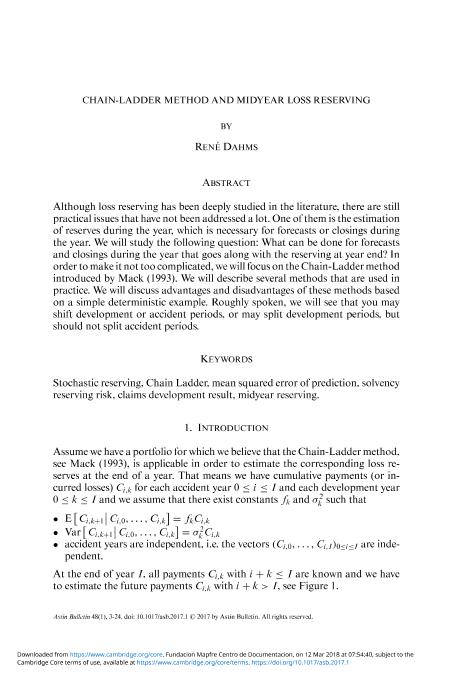Chain-ladder method and midyear loss reserving

Contenido multimedia no disponible por derechos de autor o por acceso restringido. Contacte con la institución para más información.
| Tag | 1 | 2 | Valor |
|---|---|---|---|
| LDR | 00000cab a2200000 4500 | ||
| 001 | MAP20180005404 | ||
| 003 | MAP | ||
| 005 | 20180320110103.0 | ||
| 008 | 180223e20180101bel|||p |0|||b|eng d | ||
| 040 | $aMAP$bspa$dMAP | ||
| 084 | $a6 | ||
| 100 | $0MAPA20120018068$aDahms, René | ||
| 245 | 1 | 0 | $aChain-ladder method and midyear loss reserving$cRené Dahms |
| 520 | $aAlthough loss reserving has been deeply studied in the literature, there are still practical issues that have not been addressed a lot. One of them is the estimation of reserves during the year, which is necessary for forecasts or closings during the year. We will study the following question: What can be done for forecasts and closings during the year that goes along with the reserving at year end? In order tomake it not too complicated,wewill focus on the Chain-Laddermethod introduced by Mack (1993). We will describe several methods that are used in practice.We will discuss advantages and disadvantages of these methods based on a simple deterministic example. Roughly spoken, we will see that you may shift development or accident periods, or may split development periods, but should not split accident periods. | ||
| 650 | 4 | $0MAPA20080592042$aModelos matemáticos | |
| 650 | 4 | $0MAPA20080597733$aModelos estadísticos | |
| 650 | 4 | $0MAPA20080586447$aModelo estocástico | |
| 650 | 4 | $0MAPA20080602437$aMatemática del seguro | |
| 773 | 0 | $wMAP20077000420$tAstin bulletin$dBelgium : ASTIN and AFIR Sections of the International Actuarial Association$x0515-0361$g01/01/2018 Volumen 48 Número 1 - enero 2018 , p. 3-24 |

